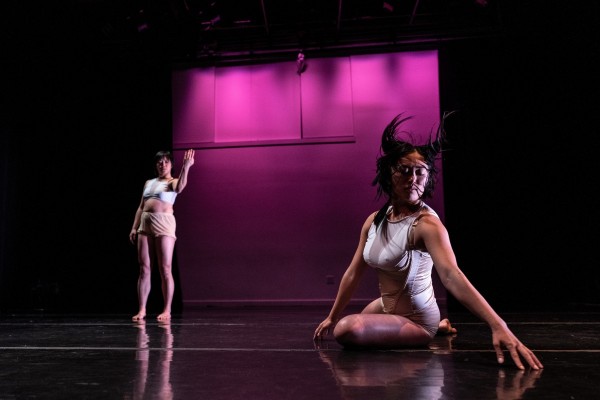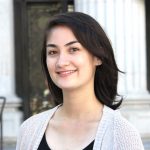For this lab, you'll be exploring how the body responds to cultural and sensory experiences in public spaces through this lab. What excites you about approaching this topic collaboratively?
Kim: Dasha comes from an architectural background and also has an interest in social art practice. I am also endlessly asking myself how I can use the body as an instrument of communication, spatial manipulation, and take the practice out of a very self-involved place.
Naturally, I was drawn to the idea of interfacing with the outside spaces that make the Tenderloin neighbourhood particularly unique to San Francisco; with the number of sidewalk spaces that provide informal space for individuals of the neighbourhood to congregate. It’s a rollercoaster walking through and witnessing the exchanges between neighbours and small groups that have formed, usually close to a convenience store. I wanted to ask myself and Dasha how we could build a workshop and performance that extrapolated these communal elements around getting your needs met: buying, selling, trading of items, checking in with your friend who lives in the SRO building two blocks away, policing the space that inhabits four lawn chairs with the same people sitting in them every day. These instances are social engagements existing in outdoor, informal, casual space.
Dasha and I envisioned this informal space as a space that has “infinite possibilities” in a way that indoor, closed institutions don’t provide. Dasha and I defined indoor, closed institutions as places that grant access for people with money to spend or to pursue a service (public/private). I have been spending the last few days gathering cultural and sensory data by walking through four blocks — Taylor, Turk, Eddy, and Mason — and stopping by and chatting with whoever is willing to talk. I am walking through as a guest in these informal spaces, but asking myself to be permeable and open with eye contact or conversation if prompted. This is how we are gathering data that will be synthesised and presented on Tuesday.
My excitement for pursuing this project collaboratively comes from a shared understanding of how we view social engagement in outdoor space. We agreed that there was a time when architecture was defining the purpose of spaces, but we also agreed that if a community lacks access to multipurpose, free spaces, then an outdoor, informal space becomes the most accessible option, and could define its purpose based off of who is showing up in the space.
Dasha: Conversations with Kim on this topic have been fascinating. Her improvisational rendering of intuitive yet analytical theories and techniques in her discipline is incredibly sophiscated. As Kim noted, our conversations have ranged from the sensory perceptions of an organ to the body’s place in urban space to the manifestation of formal and informal urban spaces in our cultures socio-economic structures. Kim has a great ability to talk both about these broad issues and her awareness of the impacts of these broad issues on specific movements of her body. What was then inspiring was her articulation of how the movements of different parts of a body relate and translate into others.
Another exciting revelation in our discussions was just how many fundamental principles dance and architectural design share — the basics of both fields are graphic, sensory, and perceptive — the outcomes may look different but the underlying processes are rooted in similar geometries and considerations.

What past projects or experiences have inspired your approach towards this Matchbox lab?
Kim: Dasha’s 7,000 mile road trip project, A Franchise of Difference, immensely inspired me. It was a fascinating juxtaposition of research of highway patterns and inquiry into whether or not there was a repeating subset of data that existed amongst the miles of traversed geography. I loved that the data-gathering process was a simple task — a road trip, but the complexity unfolded in interactions with people in each town as Dasha interviewed people along the way. This process speaks a lot to what we will be presenting on Tuesday!
Dasha: Watching Kim’s performance video, Steep in Hurr, and discussing her choreographic process was inspiring as it revealed her interest in parameters and in creating contexts and responding to them in an iterative fashion. This work and these conversations have yielded the framing concept that we are working on. It was also so exciting to discover that not only is Kim familiar with the cultural context of the interior of CounterPulse as an arts center, but she is also sensitive to and familiar with the details of the lives of people who use the exterior spaces around it. In her daily practice, she builds a delicate awareness of the characters, cares, and needs of individuals whose paths cross with hers.
What do you hope participants will walk away thinking as they leave this lab?
Kim: Our intention is to both sensitise the participant to the interactions and informal spaces being constantly built around the Tenderloin as well as to the needs of people around them. My hope is the people who come to our workshop and performance understand that their level of interaction, big or small, also has an effect on these outdoor informal spaces of the Tenderloin.
Dasha: We hope participants come away thinking about two main themes: 1. How different types of daily needs could be better considered in public spaces, and 2. How the body, architecture, and public space can form recursive relationships that help us better understand the people around us.
What inspires you most about working with your collaborator?
Kim: When I conceptualise with Dasha, I feel like we have infinite possibilities for projects to pursue. She has an incredible capacity to speak in the abstract, but can understand the poetic resonance that our collaborative concept has, and for that, I am so happy we are paired together!
Dasha: I love talking to Kim both as a friend and as a collaborator. We use similar language for very different practices and we share a great interest in informal discovery of human stories. We immediately gelled on this and it felt almost uncanny that we had been paired.
*Photo credit: Robbie Sweeny for Kim Ip
